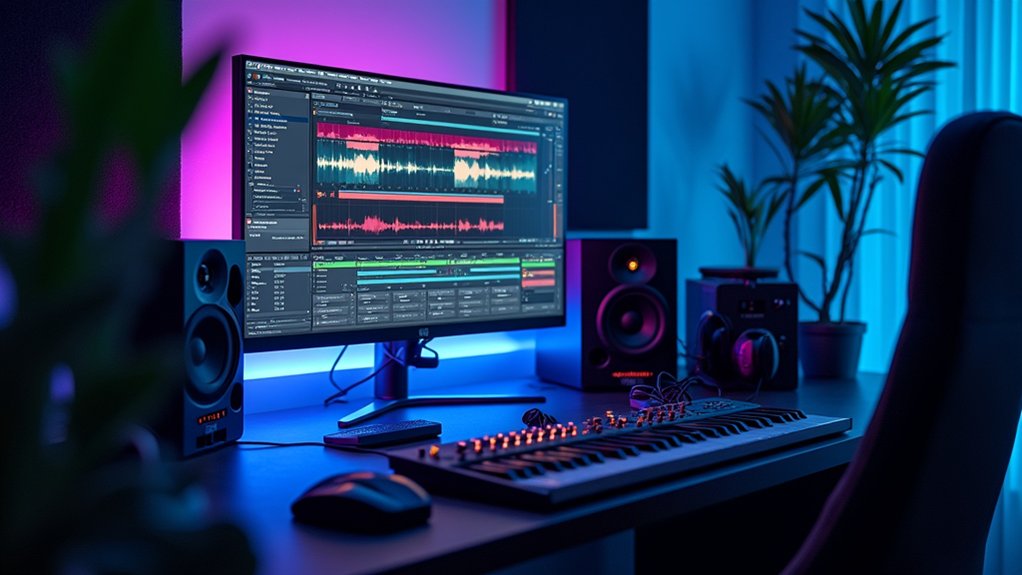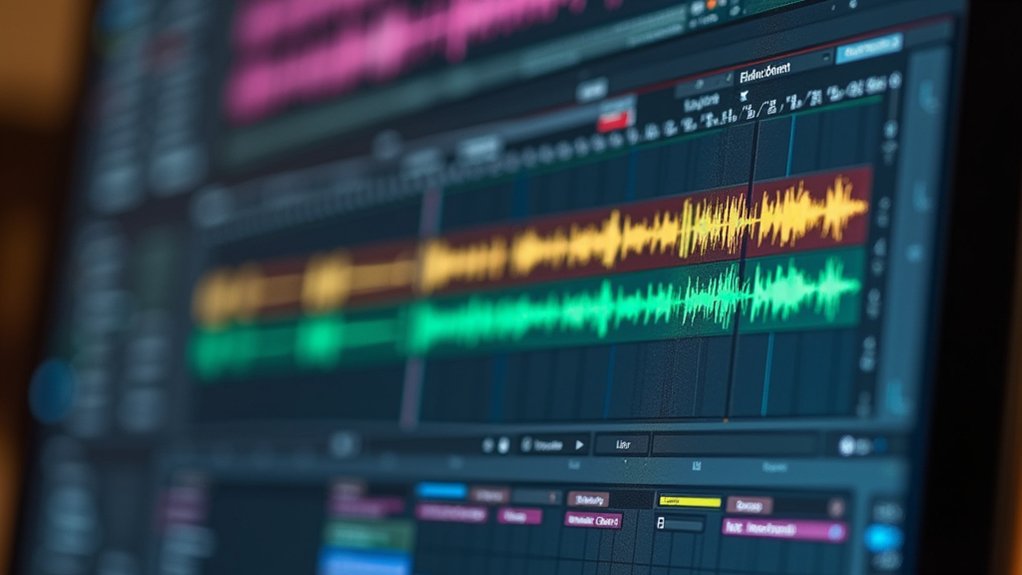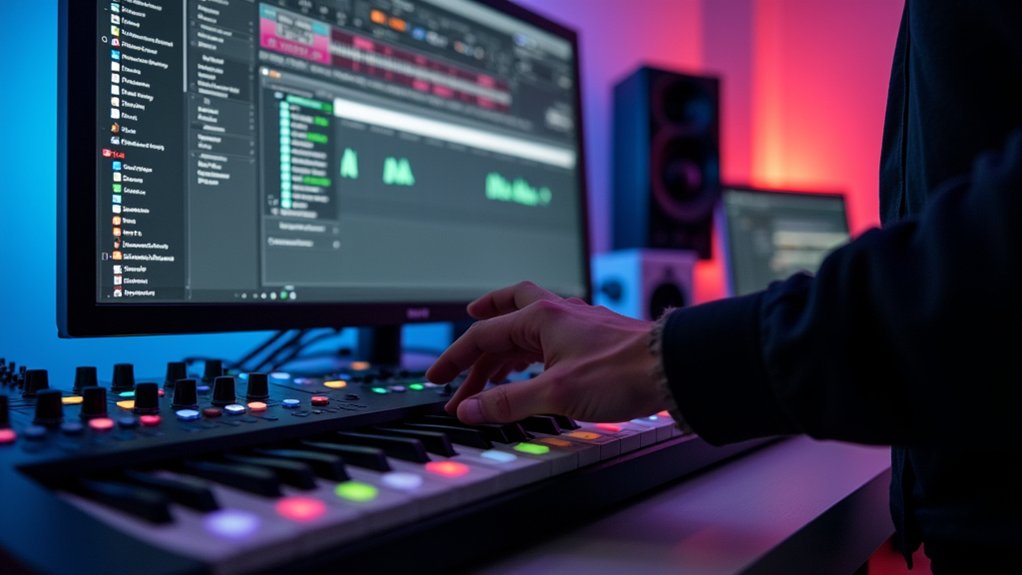Producers seeking FL Studio alternatives can choose from advanced paid DAWs like Ableton Live, Logic Pro, and Cubase, each offering robust workflow features, extensive plugin support, and genre-specific toolsets. Budget-friendly options such as Reaper or Cakewalk by BandLab deliver professional capabilities, while free DAWs like LMMS cater to beginners needing solid pattern-based sequencing. Cross-platform compatibility, bundled instruments, and the latest AI-driven enhancements distinguish these platforms. Further exploration will reveal the best fit for different production goals.
Key Takeaways
- Ableton Live and Logic Pro offer professional-grade features for electronic music and are strong paid alternatives to FL Studio.
- Cakewalk by BandLab is a top free DAW for Windows, providing unlimited tracks and advanced MIDI tools at no cost.
- LMMS is a free, beginner-friendly DAW with a pattern-based workflow ideal for beatmaking and electronic music.
- Reaper offers robust audio and MIDI capabilities, is cross-platform, and features an affordable one-time license.
- Pro Tools Intro and Stagelight provide free entry points for newcomers, with scalable options for future upgrades.
Key Considerations When Choosing a DAW
How should one approach selecting a digital audio workstation amid a saturated market? The evaluation process begins with hardware compatibility and system requirements, ensuring peak performance on the user’s preferred operating system. Plugin compatibility is critical; confirming support for VST, AU, or proprietary formats dictates the breadth of sound design and integration with third-party tools. The DAW’s suitability for electronic music production or recording live instruments must align with project goals. Pro Tools excels in complex audio editing with features like Elastic Audio and advanced tools, targeting professional audio engineers. Bundled resources—such as virtual instruments and effects—can offset additional expenditures and expedite workflow. Price remains a decisive factor, with solutions ranging from premium offerings to free alternatives, each with differing licensing models. Finally, a user-friendly interface fosters efficiency, reducing the learning curve and maximizing productivity regardless of experience level or production environment.
Top Paid Alternatives to FL Studio
Among premium digital audio workstations, several contenders rival FL Studio by addressing diverse production needs and workflow preferences.
Cubase stands out for its user-friendly interface and accelerated workflow, supported by extensive tutorials, making it one of the top paid alternatives to FL Studio.
Ableton Live excels in electronic music production and live performance with its unique Session View and integrated plugin suite.
Logic Pro, exclusive to macOS, delivers a thorough music production environment, advanced MIDI recording, and a robust library of instruments and effects.
Reaper offers cross-platform compatibility, highly customizable features, and robust audio and MIDI capabilities at a competitive price, appealing to technically minded users.
Pro Tools remains the standard in professional studios, renowned for its advanced editing and superior integration in complex recording sessions.
Leading Free DAWs for Budget-Conscious Producers
For producers seeking zero-cost solutions, LMMS provides an accessible workflow with a familiar layout ideal for beginners shifting from pattern-based sequencing.
Cakewalk by BandLab delivers full-fledged pro-level features, including advanced MIDI routing and unlimited track support, rivaling paid platforms for Windows users.
Meanwhile, Stagelight stands out with its streamlined, touch-optimized interface, mirroring Ableton Live’s session view for intuitive arrangement and loop-based production.
LMMS for Beginners
Widely recognized for its no-cost accessibility, LMMS (Linux MultiMedia Studio) delivers robust digital audio production tools across Windows, macOS, and Linux platforms.
The free version of LMMS is equipped with a user-friendly interface that echoes the familiar workflow of FL Studio, providing seamless adaptation for music production newcomers and FL Studio migrants alike. Producers benefit from unlimited track recording and playback, enabling intricate project layering without track count restrictions.
LMMS ships with an extensive suite of built-in instruments and effects, supporting a diverse range of sonic experimentation. Its VST plugin support further broadens creative horizons by integrating third-party sound libraries and tools.
Extensive tutorials and a strong online support community reduce onboarding friction, making LMMS particularly accessible for aspiring producers on a budget.
Cakewalk’s Pro Features
Building on the accessibility showcased by LMMS, Cakewalk stands out as a fully-featured DAW that targets producers seeking professional-grade capabilities without financial investment.
This Windows-exclusive platform equips users with a customizable interface—specifically, the Skylight workspace—allowing tailored layouts and workflow optimization.
The DAW’s extensive collection of virtual instruments and integrated effects offers producers a robust sonic palette, facilitating end-to-end music production without the need for third-party expansions.
Central to its mixing prowess is the advanced ProChannel mixer, renowned for its extensive routing options and modular processing, enabling precise control over signal chains and professional-level mix refinement.
Cakewalk’s commitment to unrestricted access to all professional-level tools establishes it as a go-to solution for gear-aware, budget-conscious music producers working within Windows operating systems.
Stagelight’s User Interface
Visual coherence defines Stagelight’s user interface, which adopts a layout reminiscent of Ableton Live to streamline the shift for users familiar with other leading DAWs such as FL Studio. The professional-looking interface is purpose-built for workflow efficiency, supporting rapid music production across both Mac and Windows platforms.
Stagelight’s design emphasizes intuitive access to core production functions, making tasks like MIDI sequencing, audio recording, and sample manipulation straightforward for both novices and experienced producers. Central to its appeal are built-in tools optimized for loop creation, which accelerate track development and encourage creative iteration.
- Cross-platform compatibility (Mac and Windows) maximizes accessibility.
- Integrated loop creation tools facilitate non-linear track construction.
- Streamlined MIDI sequencing and audio recording enhance workflow efficiency.
- Modular interface supports drag-and-drop sample manipulation for rapid arrangement.
DAWs for Electronic Music and Beatmaking
DAWs geared toward electronic music and beatmaking prioritize loop-based workflow efficiency, enabling rapid pattern creation and flexible arrangement. Essential plugins—such as drum machines, synthesizers, and multi-FX racks—are often bundled or supported, facilitating genre-specific sound design and manipulation. Platform choices like FL Studio, Ableton Live, LMMS, Cakewalk by BandLab, and Cubase each offer distinct toolsets optimized for beat-centric production. Understanding the FL Studio interface is crucial for enhancing creative workflow, as it allows for efficient sound selection and management.
Loop-Based Workflow Advantages
Efficiency defines the loop-based workflow favored in electronic music and beatmaking, as exemplified by platforms like FL Studio and Ableton Live.
Loop-based DAWs streamline music production by utilizing pre-recorded loops and intuitive step sequencers, allowing rapid composition and flexible arrangement. The session view in Ableton Live provides real-time performance capability, enabling electronic music producers to experiment, improvise, and trigger clips seamlessly.
Deep integration of MIDI and audio manipulation supports the crafting of unique rhythmic patterns and intricate soundscapes.
Key workflow advantages include:
- Non-linear arrangement via session view for spontaneous creativity.
- Fast beat construction using intuitive step sequencers and pattern-based editing.
- Extensive built-in plugins for broad sonic possibilities.
- Robust MIDI and audio handling for complex, layered productions.
These features enhance loop-based DAWs as essential tools in modern electronic music creation.
Essential Plugins and Effects
While workflow speed and creativity hinge on DAW architecture, the selection of built-in plugins and effects ultimately shapes the sonic potential for electronic music producers.
FL Studio is renowned for its all-in-one suite, featuring robust synthesizers, samplers, and a diverse array of effects—crucial for modern beatmaking and intricate MIDI programming.
Alternatives such as Ableton Live and Logic Pro compete with extensive libraries of virtual instruments, sample manipulation engines, and advanced MIDI tools, optimizing electronic production workflows.
For those on a tight budget, Cakewalk by BandLab provides a formidable arsenal of professional-grade plugins and instruments at no cost.
DAWs like Reaper emphasize flexibility, offering broad VST support so producers can curate unique soundscapes with third-party effects and instruments, maximizing creative potential across production environments.
Best Options for Recording Live Instruments and Bands
Professional studio environments and home setups alike demand digital audio workstations that excel in capturing the nuances of live instruments and full bands.
When evaluating DAWs for music recording, workflow efficiency and feature depth are essential. Pro Tools remains the industry benchmark, offering advanced audio and MIDI capabilities optimized for multi-track recording and editing.
For Windows users, Cakewalk by BandLab provides robust features—including VST support and precise mixing tools—at no cost.
Logic Pro, with its sophisticated MIDI editing and suite of virtual instruments, is a top-tier choice for macOS-based bands.
Ableton Live, while renowned for electronic music, leverages its session view and flexible audio routing for live instrument recording.
Key DAW options include:
- Pro Tools
- Cakewalk by BandLab
- Logic Pro
- Ableton Live
Cross-Platform DAWs and System Compatibility
How does cross-platform compatibility influence workflow flexibility and studio integration? For producers utilizing digital audio workstations, seamless switch between operating systems is essential. Cross-platform DAWs like Cakewalk by BandLab and Reaper exemplify system compatibility, supporting Windows, macOS, and Linux. This allows for uninterrupted music production regardless of hardware or OS changes. Lightweight design, as seen in Reaper, minimizes resource demands, optimizing performance even on modest setups. VST and AU support guarantees integration of third-party plugins, maintaining sonic palette consistency across platforms. When evaluating DAWs, verifying both operating system support and plugin compatibility is fundamental for a future-proof workflow. The table below highlights the emotional impact of flexible system compatibility:
| Flexibility | Frustration Avoided |
|---|---|
| Seamless switch | No lost sessions |
| Hardware freedom | Reduced limitations |
| Plugin continuity | Creative confidence |
Latest Updates and Must-Have Features in Modern DAWs
Advancements in digital audio workstation technology have accelerated the integration of AI-powered tools, enhanced plugin suites, and workflow optimizations, setting new standards for modern music production environments.
The latest version of FL Studio 2024 debuts advanced features like AI-driven synths, streamlining electronic music production.
Ableton Live 12 delivers a unique workflow with cutting-edge MIDI tools and a modernized interface, targeting both professionals and DAWs for beginners.
Logic Pro’s 2024 update introduces AI session musicians and a stem splitter, optimizing editing tools for seamless music production and audio manipulation.
Pro Tools has focused on accessibility with Pro Tools Intro, providing essential tools for newcomers.
Meanwhile, Reaper 7 sustains its affordability while implementing innovative track management.
- AI-powered synths and session musicians
- Enhanced MIDI and editing tools
- User-friendly free versions (Pro Tools Intro)
- Affordable, versatile DAWs (Reaper 7)
Frequently Asked Questions
Which DAW Is Most Similar to FL Studio?
For users seeking FL Studio features, workflow, MIDI sequencing, automation, plugins, effects, samples, performance tools, expansions, and community support, LMMS offers the most similar DAW experience, closely emulating FL Studio’s gear-aware environment and creative process.
What Is Similar to FL Studio but Free?
When evaluating free DAW options, LMMS and Cakewalk stand out as open source music software, offering budget friendly alternatives with MIDI support, plugin integration, and active community support, though free DAWs may lack advanced workflow features and premium plugins.
What DAW Did Kanye Use?
Kanye West’s creative process prominently features FL Studio, utilizing its plugins for distinctive sound design and genre fusion. His production techniques also involve Ableton Live, hardware synths, and collaborative workflows, mirroring influential producers and informing DAW comparison charts for hip hop.
Which DAW Is Most Beginner Friendly?
When evaluating which DAW is most beginner friendly, one should assess user interface clarity, workflow efficiency, essential features, MIDI capabilities, audio recording, project organization, available learning resources, community support, and pricing options to optimize initial user experience and technical growth.
Conclusion
Selecting the ideal DAW hinges on workflow preferences, required feature sets, and hardware compatibility. From industry stalwarts like Ableton Live and Logic Pro to robust free solutions such as Cakewalk and Tracktion, each platform caters to distinct production pipelines—whether sample-based sequencing, MIDI programming, or multitrack audio recording. Evaluating plugin support, automation capabilities, and cross-platform stability guarantees producers maximize creative efficiency, making the right DAW choice integral to a streamlined and effective music production environment.




